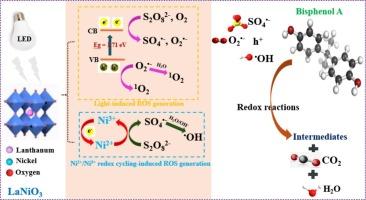Low-power visible LED driven persulfate-assisted degradation of phenolics using narrow-bandgap lanthanum perovskites
IF 6.7
2区 工程技术
Q1 ENGINEERING, CHEMICAL
引用次数: 0
Abstract
Persulfate (PS, S2O82−) based heterogeneous photocatalytic activation has sparked great scientific interest because of its effectiveness and environmental friendliness. Nevertheless, it remains a challenge to find low-energy consuming, environmentally acceptable light sources for PS activation that balance energy consumption and photocatalytic efficiency while providing more design flexibility for different kinds of photocatalytic reactors. Herein, a series of lanthanum perovskites (LaMO3; M = Ni, Co, Cu, Fe) were synthesized, characterized, and evaluated for efficient degradation of phenolic compounds via PS activation using low power-consuming visible light-emitting diodes (LEDs) as a source of light. The effects of key influencing reaction parameters on degradation efficiency were thoroughly evaluated. In comparison to other perovskite catalysts, LaNiO3 exhibited 98.4 % bisphenol A degradation efficiency with 69.3 % TOC removal within 50 min, owing to accelerated Ni2+/Ni3+ redox cycling, decreased rate of e−/h+ recombination, effective charge separation, and electron mobility. Additionally, over 91.0 % degradation efficiencies were maintained over a broad pH range (3.0–11.0), and for other phenolic compounds (phenol (95.8 %), 4-chlorophenol (85.7 %), and 4-nonylphenol (100 %)). Notably, the LaNiO3/PS/Vis-LED system displayed excellent stability and reusability after five reuse cycles. Further, humic acid (HA) and inorganic ions have minimal negative effects on degradation efficiency. Radical quenching tests indicate that SO4•-, •OH, h+ and O2•- were dominant reactive species in the LaNiO3/PS/Vis-LED system. These findings shed light on the treatment of phenolic polluted wastewater through persulfate activation and provide new approach for application of low-power consuming visible-LEDs in water treatment.

低功耗可见LED驱动过硫酸盐辅助苯酚的窄带隙镧钙钛矿降解
过硫酸盐(PS, S2O82−)基非均相光催化活化因其高效和环境友好性引起了科学界的广泛关注。然而,寻找低能耗、环境可接受的PS活化光源,平衡能耗和光催化效率,同时为不同类型的光催化反应器提供更多的设计灵活性,仍然是一个挑战。本文合成了一系列镧钙钛矿(LaMO3; M = Ni, Co, Cu, Fe),并利用低功耗的可见发光二极管(led)作为光源,通过PS活化对酚类化合物的有效降解进行了表征和评价。全面评价了关键影响反应参数对降解效率的影响。与其他钙钛矿催化剂相比,LaNiO3由于加速了Ni2+/Ni3+氧化还原循环,降低了e - /h+的重组速率,有效的电荷分离和电子迁移率,在50 min内对双酚A的降解效率为98.4%,TOC去除率为69.3%。此外,在较宽的pH范围内(3.0-11.0)和其他酚类化合物(苯酚(95.8%),4-氯苯酚(85.7%)和4-壬基苯酚(100%)),降解效率保持在91.0%以上。值得注意的是,经过5次重复使用循环后,LaNiO3/PS/Vis-LED系统显示出出色的稳定性和可重用性。此外,腐植酸(HA)和无机离子对降解效率的负面影响最小。自由基猝灭实验表明,在LaNiO3/PS/Vis-LED体系中,SO4•-、•OH、h+和O2•-是主要的活性物质。这些研究结果为过硫酸盐活化处理酚类污染废水提供了新的思路,为低功耗可见led在水处理中的应用提供了新的途径。
本文章由计算机程序翻译,如有差异,请以英文原文为准。
求助全文
约1分钟内获得全文
求助全文
来源期刊

Journal of water process engineering
Biochemistry, Genetics and Molecular Biology-Biotechnology
CiteScore
10.70
自引率
8.60%
发文量
846
审稿时长
24 days
期刊介绍:
The Journal of Water Process Engineering aims to publish refereed, high-quality research papers with significant novelty and impact in all areas of the engineering of water and wastewater processing . Papers on advanced and novel treatment processes and technologies are particularly welcome. The Journal considers papers in areas such as nanotechnology and biotechnology applications in water, novel oxidation and separation processes, membrane processes (except those for desalination) , catalytic processes for the removal of water contaminants, sustainable processes, water reuse and recycling, water use and wastewater minimization, integrated/hybrid technology, process modeling of water treatment and novel treatment processes. Submissions on the subject of adsorbents, including standard measurements of adsorption kinetics and equilibrium will only be considered if there is a genuine case for novelty and contribution, for example highly novel, sustainable adsorbents and their use: papers on activated carbon-type materials derived from natural matter, or surfactant-modified clays and related minerals, would not fulfil this criterion. The Journal particularly welcomes contributions involving environmentally, economically and socially sustainable technology for water treatment, including those which are energy-efficient, with minimal or no chemical consumption, and capable of water recycling and reuse that minimizes the direct disposal of wastewater to the aquatic environment. Papers that describe novel ideas for solving issues related to water quality and availability are also welcome, as are those that show the transfer of techniques from other disciplines. The Journal will consider papers dealing with processes for various water matrices including drinking water (except desalination), domestic, urban and industrial wastewaters, in addition to their residues. It is expected that the journal will be of particular relevance to chemical and process engineers working in the field. The Journal welcomes Full Text papers, Short Communications, State-of-the-Art Reviews and Letters to Editors and Case Studies
 求助内容:
求助内容: 应助结果提醒方式:
应助结果提醒方式:


